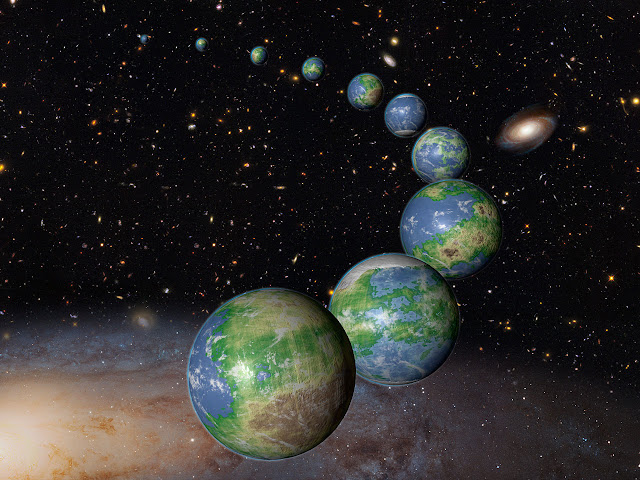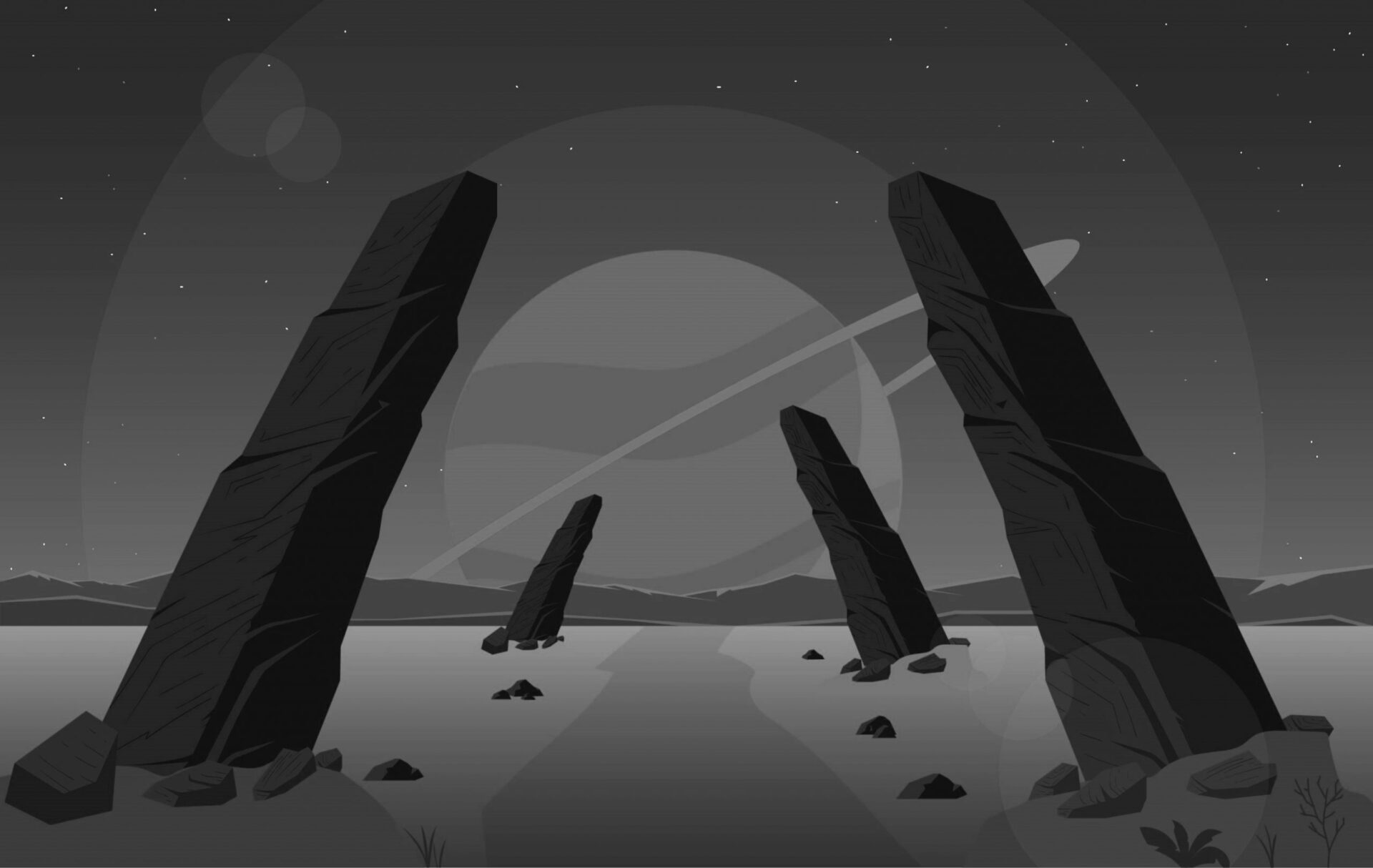Clearly it is possible to imagine exoplanets which are less habitable than Earth but is it possible to imagine one that is better than Earth? It is interesting to push the habitability envelope to investigate how alternative conditions would change how life develops but what changes would be more favourable for life?

The concept of Superhabitable Worlds has been proposed in the scientific literature as an exoplanet were life is more likely to evolve and produce greater diversity than on Earth. This paper discussed the various parameters mentioned below and suggested that they could all produce a planet that was more suited for life than Earth. Such planets would then be a better target for observation to determine if aliens really do exist. Of course, that doesn’t in any way mean a speculative evolution project has to conform to these parameters but it is an interesting viewpoint that is worth considering.
Host Star Mass
Lifetime
As discussed previously on this blog stars less massive than the sun have longer lifetimes. This means that planets around these stars have a longer period for life to begin and evolve into complex ecosystems with increased biodiversity. While Earth achieved this in 4.5 billion years it is not known whether this is more or less than is typical. Planets around stars with a lower mass than the Sun are described as superhabitable.
Illumination
Stars more massive than the Sun produce a greater proportion of their illumination as blue and ultraviolet light. Conversely, stars less massive than the sun produce more red and infrared illumination. For this reason, the photosynthetic process that produces oxygen on Earth would be most efficient around a star that is similar to the Sun or only slightly less massive. Other forms of photosynthesis are theoretically possible but may be more challenging. More on photosynthesis is planned for later.
Ultraviolet
Some level of ultraviolet (UV) illumination is believed to have been required to produce chemicals required for life to start on Earth, however, intense UV is harmful to DNA. Therefore, a superhabitable planet requires a little but not too much UV. All stars exhibit strong UV activity when they are young, however, this process continues for longer for stars significantly less massive than the Sun. Stars slightly less massive than the Sun are therefore deemed optimal as they produce almost as much UV as the Sun initially but then become quiet in a relatively short period of time.
Planet position
Location in the habitable zone
Earth is located at the inner edge of the habitable zone. Therefore, only a small change is required to cause a runaway greenhouse state that would make Earth to hot for life. A planet located more centrally in the stellar habitable zone would be optimal for life as small changes in conditions would be less likely to make the planet too hot or too cold.
Surface temperature
A planet slightly warmer than Earth may have extended tropical zones which enhance biodiversity. This suggests that the planet should be slightly closer to the sun or have a thicker atmosphere to increase average planetary temperature.
Multihabitability and panspermia
If multiple planets and or moons in a solar system are suited for life then there exists the possibility that microbes could be ejected from one planet during a meteorite impact and survive to land on another. This process is known as panspermia. Therefore a planet in a system with other nearby habitable planets is deemed to be superhabitable. This would of course be an interesting speculative evolution project to consider how life on closed spaced planets (such as those around TRAPPIST-1) could spread and evolve in parallel.
Planet Mass
Total surface area
A planet with a larger radius has more space for life to develop. As larger radius planets tend to be more massive this suggests that more massive planets than Earth are superhabitable. An extremely uneven surface would also produce the same effect however.
Plate tectonics
Plate tectonics drive important geochemical cycles that stabilise a planet’s climate in a state more suited for life. Since internal heat drives this process larger planets are considered superhabitable as they will hold their internal heat for longer. If the planet is too massive however plate tectonics are suppressed. An optimum mass is believed to be up to twice the Earth’s mass.
Atmospheric Pressure
A thicker atmosphere provides additional UV protection, reduces the day-night temperature variation and aids the global distribution of water. Since more massive planets tend to have thicker atmospheres (though this is not guaranteed) then again planets slightly more massive than Earth are suggested to be superhabitable.
Magnetic Shielding
High energy particles from interstellar space and the host star can be dangerous to biological molecules such as DNA. They can also cause atmospheric loss which is bad for habitability. More massive planets and those that rotate faster are more likely to have a magnetic field that can deflect these particles (and produce aurora at the poles) and therefore increase habitability.
Planetary Water
Habitable surface area
Water is a key element in enabling habitability and therefore a planet with a greater surface area where liquid water is possible is considered superhabitable. This does not necessarily mean open oceans and lakes as temperate land environments still permit liquid water to exist.
Shallow water
Earth’s shallow waters have higher biodiversity than the deep oceans, therefore shallower waters are expected to be optimal for life. This implies either a lower total water content or reduced topological variation.
Land-to-ocean distribution
Large continents tend to be dry in the interior and may contain vast deserts which are not conducive to life. This implies that planets with many bodies of shallow water distributed over the surface leading to islands and archipelagos produces richer habitats and is better for biodiversity.
Summary
The overall conclusion of the paper is that planets up to 50% larger than the Earth are better for biodiversity. Conversely, the star that they orbit should be slightly less massive and therefore cooler than the Sun. A K-dwarf main sequence star with a mass between 0.5 and 0.8 M☉ of the Sun seems optimal for superhabitability.
Superhabitable worlds must be considered for future follow-up observations of signs of extraterrestrial life. Considering a range of physical effects, we conclude that they will tend to be slightly older and more massive than Earth and that their host stars will likely be K dwarfs. This makes Alpha Centauri B, member of the closest stellar system to the Sun that is supposed to host an Earth-mass planet, an ideal target for searches of a superhabitable world.
Khthonia
Linking this back to my overview of Khthonia, the following features suggest it might actually be “superhabitable” after all.
The twin red dwarfs around which it orbits will be large red dwarfs with a mass of around 0.6 M☉ each. This produces a long stellar lifetime and illumination that is not as biased towards red/infrared as smaller red dwarfs. Ultraviolet flares will still be a “feature”, though a solution to prevent this sterilising the planet will be discussed in a future blog post.
Khthonia will be closer to its suns than Earth is to the Sun since its suns are cooler and less luminous. Red dwarfs have an extended habitable zone due to cloud formation (to be discussed later) so this location will be within a large habitable zone. However, this close proximity to its suns ensures it will be tidally locked and therefore only one side will be exposed to light. This side will be warmer on average than Earth. Other planets will also have similarly close orbits so panspermia may be a possibility.
Khthonia will be slightly more massive than the Earth. This produces a larger surface area though only the sun facing side is ideal for life. Tidal heating caused by the changing gravitational tug of the binary stars will induce volcanic and tectonic activity. As Khthonia started as a mini-Neptune, even after the initial atmospheric evaporation an atmosphere thicker than Earth remains. This will balance the temperature between the two sides of the planet. Despite the slow rotation due to tidal locking the higher mass may still produce a magnetic field for protection.
Khthonia will have many small shallow seas due to lower topological variation. This is caused by the increased gravity combined with increased erosion from strong oceanic tides and high atmosphere pressure. Despite losing water along with its atmosphere shortly after formation, Khthonia will still have slightly more water than Earth, though spread over a larger surface area. Due to the heat redistribution caused by the thick atmosphere liquid water will be possible across most of the surface, with only two polar regions on the dark side containing significant ice.

Welcome to worldbuilding, speculative evolution (and allied matters)!
Ta. I need to work out what to write and, more importantly, what people are interested in. There is a lot rattling around in my head just waiting to come out though!
What we are interested in, is what is rattling around in your skull – please bring it out.
ps: an excellent post on superhabitables and what makes them them.
-anthony